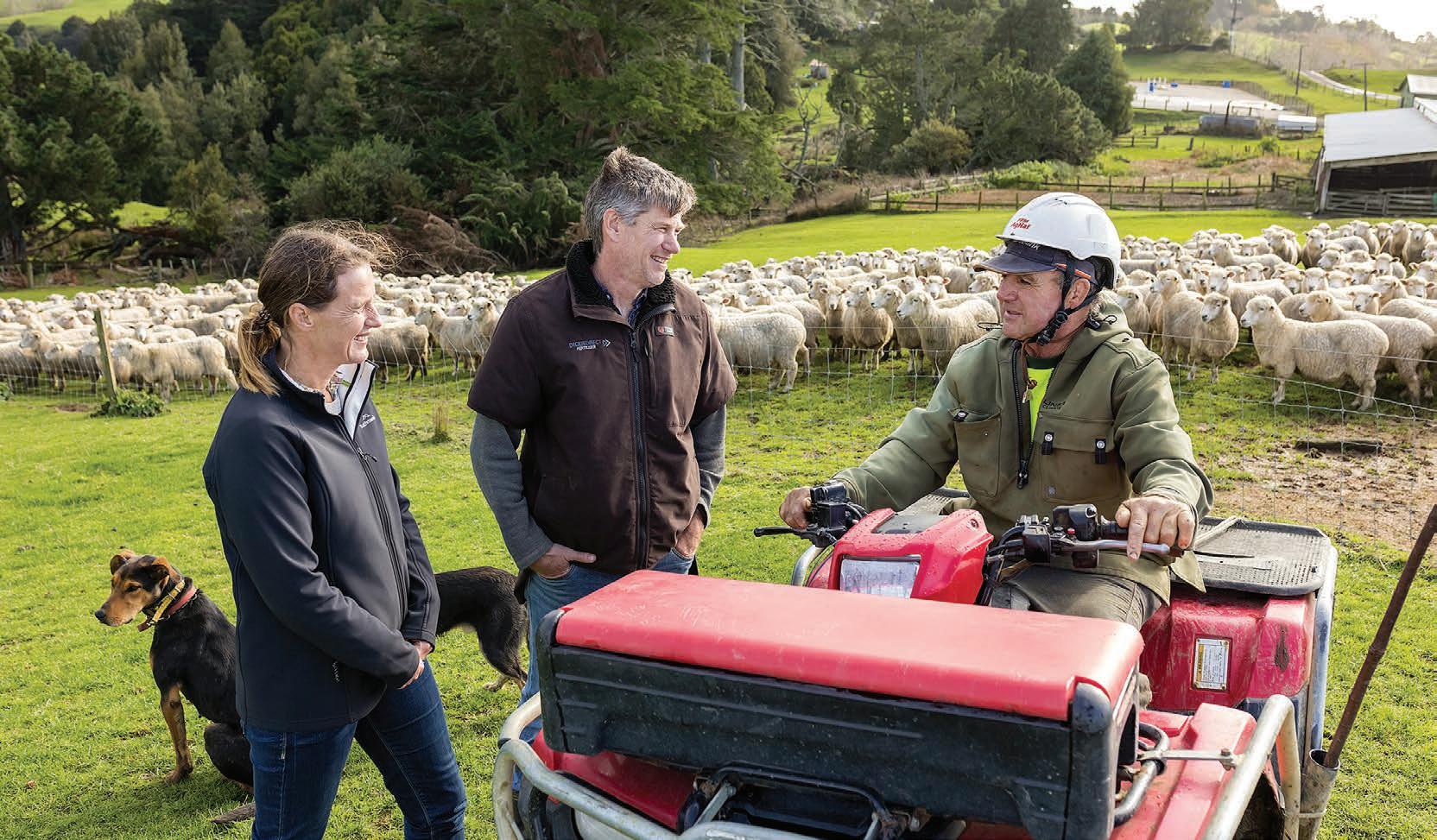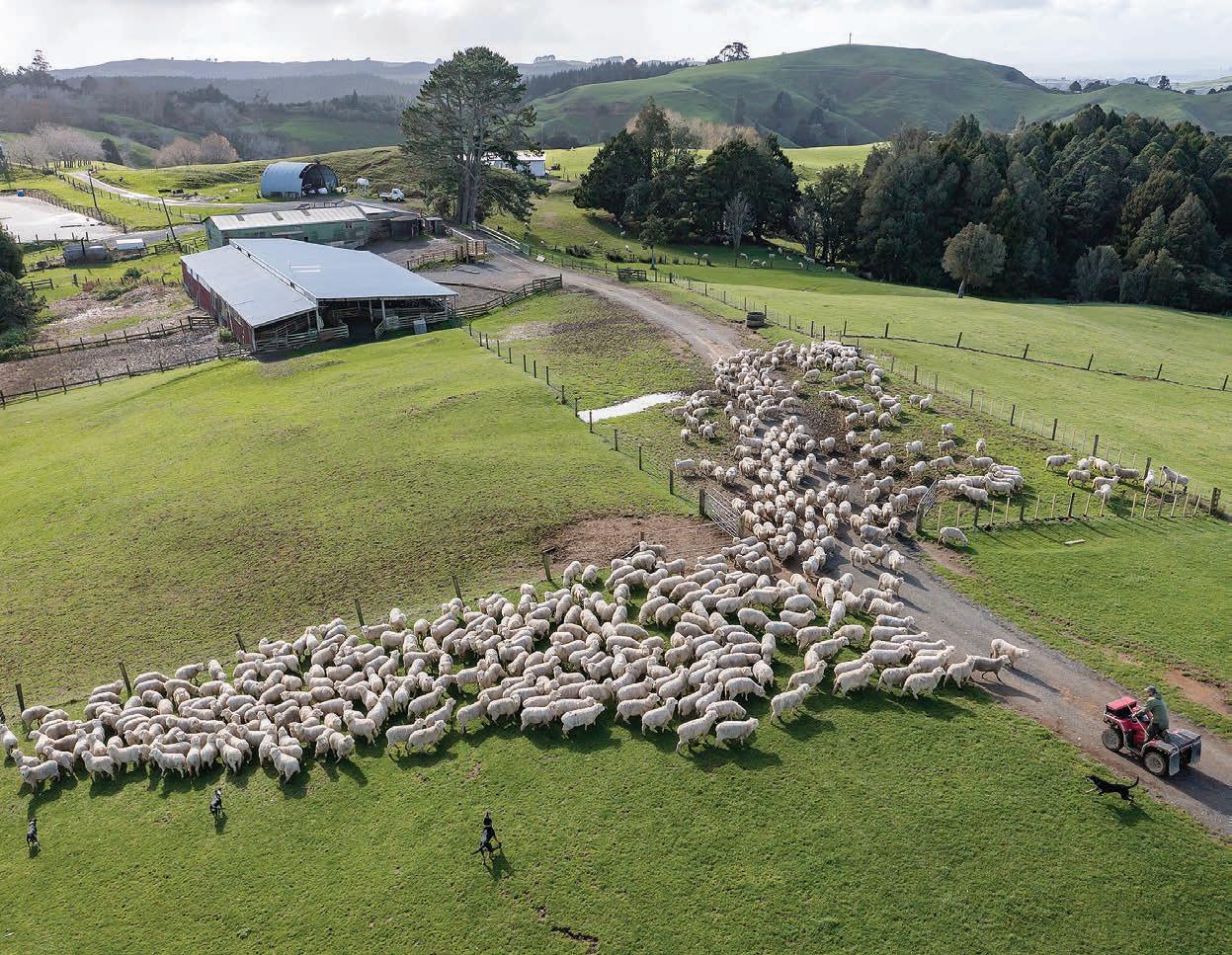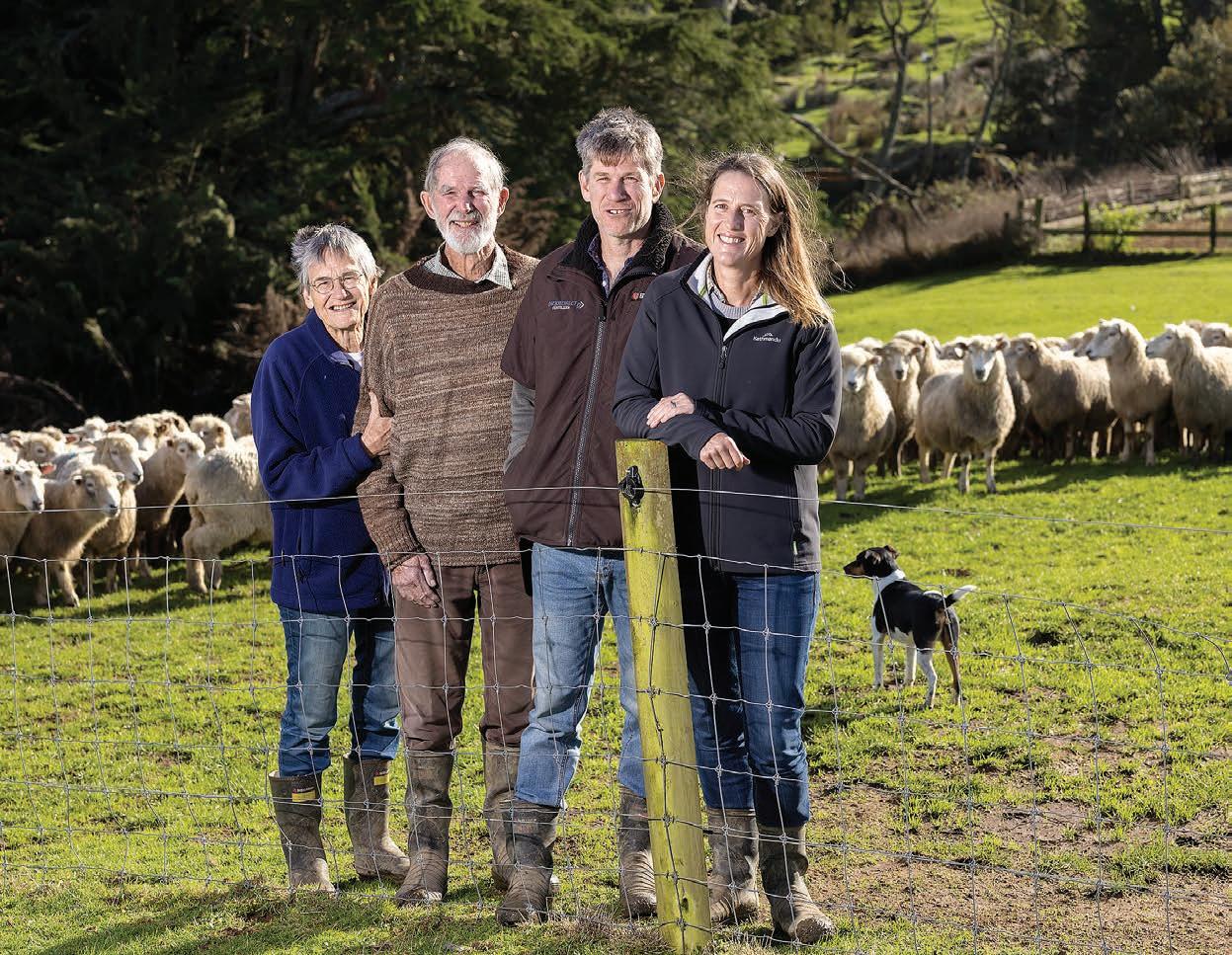
8 minute read
Changing with the times
28 FARMERS WEEKLY – farmersweekly.co.nz – July 4, 2022
On Farm Changing with the times
Waikato hill country farmers Jon and Fiona Sherlock are changing their business as the climate changes, matching stock and trading decisions to stay in tune with the evolving seasons. Gerald Piddock found out how they’ve done it.
CLIMATE change’s impact is there for Jon and Fiona Sherlock to see when they look out their window at their hill country farm during the summer.
Looking about at 1100ha Waingaro in northwest Waikato farm today the green covers – a result of persistent rain throughout June – are deceptive.
Grass growth is still on the low side as it slowly recovers from a fourth consecutive dry summer.
Rainfall over the past four years has been 10% down on the previous seven to eight years and rainfall for the combined summer and autumn seasons has been 28% down over the same period.
Not only is there less rain, when it does fall it tends to happen in big events.
“When you start talking about climate change, it’s right in our face at the moment,” Jon says.
Farming through it was, he says, “bloody challenging”.
What has made this past season unusual is how late into autumn the dry weather continued.
Going into that summer, he felt like the farm was well positioned to meet whatever nature would throw at it.
“We were set really well and despite that, it’s still a costly drought.”
It has forced them to change their farming style to adapt to the changing conditions, switching to breeding lambs and selling them as store rather than trying to finish them.
They have also switched from farming beef breeding cows to finishing trade heifers, giving them greater flexibility throughout the farming season.
The farm is hard hill country, dominated by steep class six and seven paddocks.
It sits in two blocks and is 970ha effective.
The home farm Otorohaea is 595ha effective and has been in the Sherlock family for three generations with Jon’s grandfather buying the property after the Second World War.
The second 375ha effective block, called Kerr Road, is about 20 minutes’ drive away and was bought in 2016.
The home block is used as a breeding block for their 2400 Romney breeding ewes and about 700 two-tooth ewes.
The rest of the stock are their rams and 265 two-year old beef heifers.
These cattle are bought mostly as yearlings and are finished as two-year-olds.
The lambs are sold as store at weaning at 27kg.
They keep the best of the ewe lambs as replacements and these animals are grown out on the second block.
“At weaning, everything goes off store and our ewe hoggets head on over to Kerr Road from the home farm and the two-tooths come back here at the same time,” Fiona says.
The new block has a kinder contour and was purchased to give them more options.
There, the Sherlocks finish 430 Friesian bulls.
Lambing starts in late July for the mixed age ewes, followed by the two-tooth ewes at the end of August and the hoggets from the second block in mid-September.
Jon has also fed the ewes sheep nuts and maize on occasion to maintain condition during the leadup to mating.
This is something that was started to manage the increasing number of very dry summers.
They are able to cut 200 bales of grass silage on the Kerr Road block, but the steep terrain on the home farm prevents them from using a mower there.
This has made them turn to deferred grazing, which takes a selected number of paddocks out of rotation and letting them to reseed and build up root reserves before being grazed in late summer/early autumn.
The Sherlocks volunteered to be part of an AgResearch trial on this system and found it worked well because it provided their stock with good maintenance feed in late summer.
“Those [trial] results showed that if you deferred properly and get the seed set and rejuvenate that pasture, you can get 25% more growth in that pasture in the 12 months after that deferral,” Jon says.
It has proven to be particularly useful for maintaining weight on their heifers during the dry summers.
Facial eczema is also a massive challenge.
Over the years, Jon’s father Rory has bred in facial eczema tolerant genetics into the ewe flock to make the sheep more resilient.
This policy has continued with Jon and Fiona, but they have noticed that despite flocks becoming more tolerant, the sheer numbers of spores and the length of time these counts remain high means it is still an issue.
The Sherlocks employ two full time staff.
Chris Kereopa oversees both the home farm and the Kerr Road block while Leo Jecentho works
WHAT’S UP? Fiona and Jon Sherlock get an update from farm manager Leo Jecentho. Photos: Stephen Barker/ Barker Photography


IT’S HERE: Fiona and Jon Sherlock see climate change right in front of them and have adapted their farm systems to match the changing seasons. UP AND DOWN: The farm is hard hill country, dominated by steep class six and seven paddocks.

mostly on the home block.
Chris’s partner Amy also works part time as a shepherd on the Kerr Road block.
The staff handle the day-to-day running of the farm and allow Jon and Fiona to look for roles off farm in the agribusiness industry.
Both had roles at sheep milking business Maui Milk before finishing up earlier this year.
As challenging as it is farming in the coalface of climate change, Jon and Fiona say it has also granted them opportunities to put their more marginal land into forestry.
Starting with 50ha this winter, they have plans to convert about 200-300ha of their farm into mostly radiata over the next three years, reducing their effective hectares from 970ha to 670-770ha.
The diversification into forestry is about using the right tree for the right place ethos promoted by the industry and Government and avoiding planting good farmland into pines, he says.
“It’s about using the best land class for the best return for us and for the country. At the end of the day, we have a big chunk of class seven country, which is the steepest hill country that we have and isn’t growing us much grass.”
The drier the farm got, the harder it was becoming to farm that class of land, he says.
“We have had to get ourselves out of the mindset of just being sheep and beef farmers.
“Farmers are faced with climate change in their face in terms of how it affects farming. There’s a lot of headwinds coming in terms of He Waka Eke Noa and stepping up to some of our emissions, but what sometimes gets missed is the opportunity it provides especially in hill country.
“There’s an opportunity there that doesn’t involve selling your whole farm.”
Fiona says it has changed their perspective on the future for their poorer country from a constant struggle to maintain it, to seeing it as a genuine money earner that compliments their stocking policy.
The farm has three generations of work put into it and converting the entire land to trees was not an option.
The ownership group sees Jon and Fiona sharing with Jon’s siblings, which occurred when they went through succession.
“It’s a family thing. Jon’s the third, our kids will be the fourth and it’s pretty hard to throw that away,” Fiona says.
“This is our whenua here. We have had grandparents’ ashes scattered on the hill over there and brothers and sisters married on the lawn out on the front,” she says.
“There’s that emotional attachment but on the other side of it, when you look at the numbers and where we can make the money, that class seven country in the next 15-20 years will make more money potentially than any of the rest of the country,” Jon says.
That income is based on the direction carbon prices are travelling.
The forestry will also be used to offset their stock’s emissions once a decision is made by the Government on whether it accepts the industry plan or puts biological emissions into the Emissions Trading Scheme.
It will also help future proof the farm as it will help them pay off the purchase of the second block in about 12 years.
The home block is also held in several titles, giving them further options to subdivide that land off and sell it for residential housing or as lifestyle blocks.
Converting that land to forestry will not majorly change their farming policies, apart from a proportional reduction in stock numbers and a likely reduction in sheep: cattle ratio.
The succession process was a success because of the closeness of Jon’s family and the fact they all had the same over-arching goal of wanting the farm to remain in the family.
“If you have a good relationship and everyone’s on the same page, it’s going to go well and viceversa.”
Jon’s situation was made simpler because his two siblings had off farm careers and were not looking to be involved in its dayto-day management.
They also used a farm consultant and an accountant to act as facilitators when the discussions took place, which they say is a must have because it allows all of the options to be canvassed.
“We all wanted to keep the farm but they were happy for us to run it ourselves. But in the end, we decided we wanted to be part of something bigger and the family relationship is more important than the farm.”
Looking ahead, their three children Taylor, 16, Kate, 15, and Hayden, 13, are at high school and all the shareholding families are starting to think about a succession plan for the next generation, with discussions getting underway as to how that could work.
FAMILY AFFAIR: Jon and Fiona Sherlock with Jon’s parents Rory and Sue and dog Alfie.


